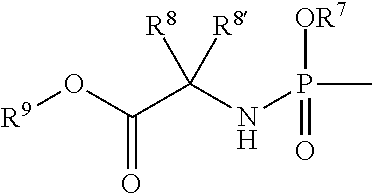Uracyl cyclopropyl nucleotides
a technology of uracyl cyclopropyl and nucleotides, applied in the field of new drugs, can solve the problems of high rate of chronic infection, and high rate of chronic infection, and achieves the effects of improving the safety of us
- Summary
- Abstract
- Description
- Claims
- Application Information
AI Technical Summary
Benefits of technology
Problems solved by technology
Method used
Image
Examples
example 1
Synthesis of Compound (1)
[0118]
[0119]To 1-naphthol (1.0 eq., 69.4 mmol, 10.0 g) in diethylether (250 ml) was added phosphorus oxychloride (1.0 eq., 69.4 mmol, 6.5 ml) and the solution was cooled to −78° C. Dry N,N-diisopropylethylamine (DIPEA; 1.0 eq., 69.4 mmol, 12.1 ml) was added and the resulting solution was left to warm to room temperature overnight. The white slurry was filtered under an inert atmosphere and all volatiles were removed to give A as a colorless liquid that was used without further purification in the next step.
[0120]A solution of A (1.0 eq., 4.6 mmol, 1.0 g) and 2-amino-propionic acid benzyl ester hydrochloride (1.0 eq., 4.6 mmol, 1.2 g) in CH2Cl2 (40 ml) was cooled down to −80° C. Dry DIPEA (2.0 eq., 9.3 mmol, 1.6 ml) was added dropwise. After 1 hour the reaction was warmed up to room temperature. Stirring was continued for 1 more hour and the solvent was removed under reduced pressure. Dry diethylether was added and the precipitate was filtered of and washed t...
example 2
[0227]Compound (F), the iodinated analogue of (C) was prepared using the following procedure.
[0228]
[0229]To a solution of (D) (1.44 g, 2.9 mmol) in dry DMF (30 mL) was added at room temperature N-iodosuccinimide (1.63 g, 7.25 mmol, 2.5 eq). The reaction mixture was heated to 110° C. and stirred at that temperature overnight. After cooling to room temperature, the reaction was quenched by the addition of a 7.5% w / v solution of NaHSO3 in saturated NaHCO3 solution. The mixture was further diluted with saturated NaHCO3 solution (250 mL) and extracted with ethyl acetate (3×200 mL). The combined organic layers were dried (Na2SO4), filtered and concentrated to yield a yellow oil. Purification by column chromatography (heptane / ethyl acetate 10 to 30% gradient) gave (E) as a white solid (1.44 g, 80%). 1H NMR (400 MHz, DMSO-d6) δ ppm 0.54 (dt, J=10.05, 5.12 Hz, 1 H) 0.62-0.70 (m, 1 H) 0.76 (dt, J=10.05, 5.12 Hz, 1 H) 0.87-1.14 (m, 29 H) 3.74-3.82 (m, 1 H) 3.96 (dd, J=12.88, 2.34 Hz, 1 H) 4.09...
example 3
Synthesis of Phosphoramidates (35-38)
[0231]
[0232](F) (120 mg, 0.316 mmol), pre-dried by co-evaporating with pyridine, was dissolved in N-methylimidazole (0.3 mL, 3.79 mmol, 12 eq) and dry dichloromethane (3.2 mL) was added at room temperature under argon a ˜1M solution of the appropriate phosphoramidochloridate (1.2 eq). The reaction was stirred for 3 hours. If required extra reagent was added. After full consumption of starting material, the reaction mixture was diluted with dichloromethane and washed with a 0.5M aqueous HCl solution. The aqueous layer was extracted with dichloromethane, and the combined organic layers were dried (Na2SO4), filtered and concentrated. The residue was purified by column chromatography (dichloromethane / methanol 1 to 10% gradient) to yield the products 36-39 as white solids (yields 68-77%).
[0233]Compound (35)
[0234]1H NMR (400 MHz, DMSO-d6) δ ppm 0.50-0.62 (m, 3 H) 1.01-1.11 (m, 1 H) 1.19-1.31 (m, 3 H) 3.84-4.00 (m, 2 H) 4.01-4.09 (m, 1 H) 4.11-4.33 (m, ...
PUM
| Property | Measurement | Unit |
|---|---|---|
| temperature | aaaaa | aaaaa |
| pharmaceutical composition | aaaaa | aaaaa |
| genetic heterogeneity | aaaaa | aaaaa |
Abstract
Description
Claims
Application Information
 Login to View More
Login to View More - R&D
- Intellectual Property
- Life Sciences
- Materials
- Tech Scout
- Unparalleled Data Quality
- Higher Quality Content
- 60% Fewer Hallucinations
Browse by: Latest US Patents, China's latest patents, Technical Efficacy Thesaurus, Application Domain, Technology Topic, Popular Technical Reports.
© 2025 PatSnap. All rights reserved.Legal|Privacy policy|Modern Slavery Act Transparency Statement|Sitemap|About US| Contact US: help@patsnap.com



